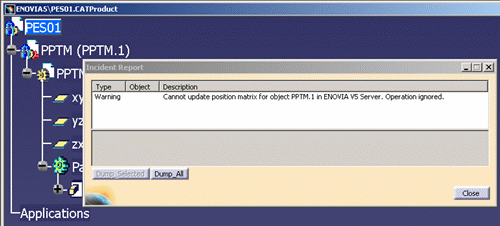-
Create a configured PRC in ENOVIA V5 VPM.

-
Create 2 Actions, ACT1 and ACT2, with 2 effectivities having intersecting ranges (for example: 1 - 50 and 20 - 100) and associate the two Actions to the PRC.
-
Set Act1 as a current Action for the PRC.
-
Send the PRC to CATIA V5.
-
Under the PRC, add a Part with simple geometry.
-
Save it in ENOVIA V5 VPM under Action ACT1.
-
In ENOVIA V5 VPM, set ACT2 as a current action.
-
Send the Part to CATIA V5.
-
Move the Part.
-
Save the assembly in ENOVIA V5 VPM. At this step, a new instance is created in ENOVIA with the effectivity of ACT2; hence the UUID of the corresponding instance in the CATIA session must be updated accordingly. But the UUID mapping is not carried out, and as a consequence the instance in CATIA remains with the old UUID leading to possible inconsistencies with the user's next interactions. In this case, a warning appears advising the user to close the current CATIA session and to reopen a new one:

-
If the user does not restart his CATIA session, moving again the Part, another warning is displayed, because in the CATIA session, Part instances are not identified with the correct UUIDs:

This warning will be displayed only once (independently of the number of item instances which have been created in EV5 and not mapped in CV5).
- Moving or Replacing instances may lead (or not) to the creation of new ones depending whether the contextual assembly is configured or not.
- Last but not least, the Replace operation actually leads to the same consequence as for the Move. The reason is that when Replace is performed in CATIA V5, interoperability will execute first a Replace operation in ENOVIA V5 and then a Move. It is this Move which will launch the warning.
![]()